Key takeaways
- Independent radio media excels in content diversity and community engagement, allowing underrepresented voices to be heard.
- Proper setup and high-quality recording tools, like Zencastr, enhance audio clarity and listener connection.
- Engaging listeners through interactive elements and personal storytelling fosters loyalty and builds a strong community.
- Preparation and creating a quiet recording environment significantly improve the quality of discussions and audience engagement.
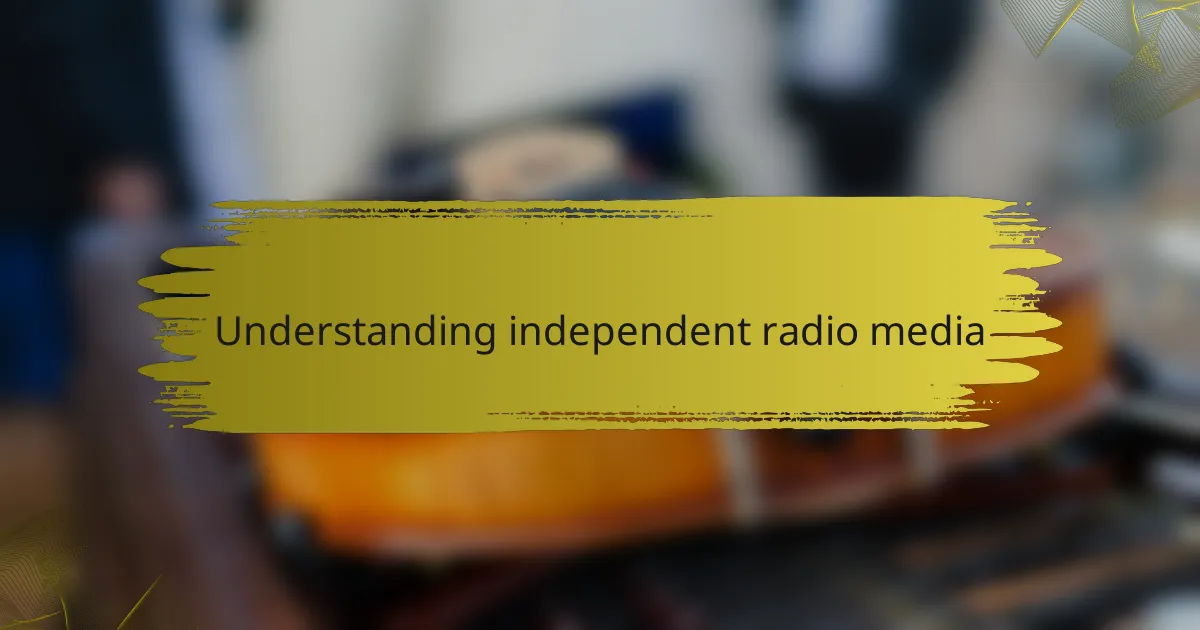
Understanding independent radio media
Independent radio media has been a game-changer in the world of broadcasting. It allows voices that may not fit into mainstream media to shine, often focusing on niche topics and underrepresented communities. Personally, I’ve found that engaging with independent stations has brought a sense of authenticity and connection that traditional media sometimes lacks.
What I appreciate about independent radio is its flexibility and creativity. Producers and hosts have the freedom to explore subjects that resonate with their passions, leading to content that feels personal and genuine. This approach not only engages listeners but also builds community bonds, as audiences feel more aligned with the values and stories shared.
Here’s a quick comparison of some key aspects of independent radio media versus traditional broadcasting:
| Aspect | Independent Radio Media | Traditional Broadcasting |
|---|---|---|
| Content Diversity | High – Focuses on niche topics and underrepresented voices | Moderate – Primarily mainstream topics |
| Community Engagement | Strong – Creates a sense of connection and involvement | Low – Often distant and one-way communication |
| Flexibility | High – Open to innovative formats and ideas | Low – Operates within established formats and regulations |
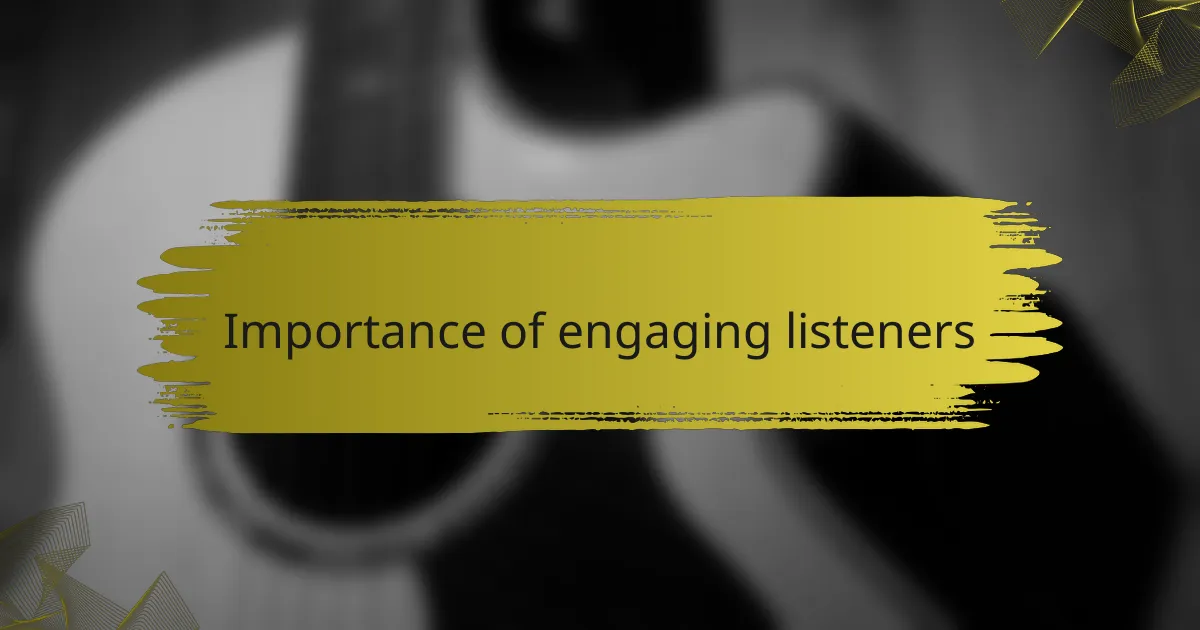
Importance of engaging listeners
Engaging listeners is crucial in independent radio media because it fosters a sense of community and loyalty. I’ve found that when listeners feel connected, they are more likely to return for future content. This engagement not only boosts listener numbers but also enhances the overall quality of discussions and interactions around the show.
From my experience, personal stories resonate most with audiences, prompting them to share their own experiences. For instance, I once shared a poignant story about overcoming challenges in the creative process, which sparked a flood of responses from listeners who related to the struggle. This kind of emotional connection is what truly keeps the audience coming back.
Here’s an overview comparing engaged versus disengaged listeners:
| Engaged Listeners | Disengaged Listeners |
|---|---|
| Active participation in discussions | Minimal interaction with content |
| Consistent feedback and shared experiences | Little to no feedback |
| Increased loyalty and return visits | Low retention and interest |
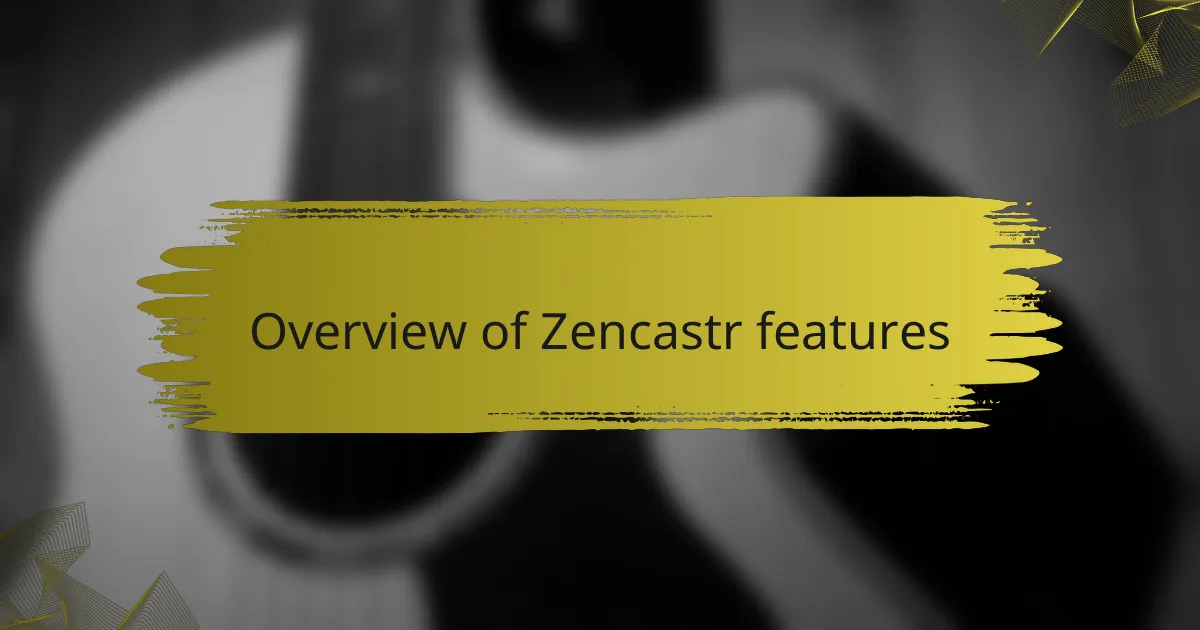
Overview of Zencastr features
Zencastr is a remarkable tool for independent radio creators like myself, particularly when it comes to recording high-quality audio remotely. Its user-friendly interface makes it easy to navigate, even for those who might be daunted by technology. I remember my first time using Zencastr; I was pleasantly surprised by how straightforward the setup was, which allowed me to focus more on my content and connection with guests rather than worrying about technical details.
Some standout features of Zencastr include:
- High-Quality Audio Recording: Records audio locally in lossless quality, which is a game-changer for sound clarity.
- Separate Tracks: Each participant is recorded on their own track, allowing for easier editing later.
- Built-in VoIP: Facilitates real-time conversation without the need for separate software.
- Automatic Backups: Ensures no audio is lost by automatically uploading recordings to the cloud.
- Post-Production Tools: Offers simple editing and mixing options to refine your recordings easily.
- User-Friendly Interface: Designed for ease of use, making it accessible for all users regardless of tech-savviness.
These features have not only enhanced my workflow but have also enriched the listening experience for my audience, making Zencastr an invaluable resource in my podcasting journey.
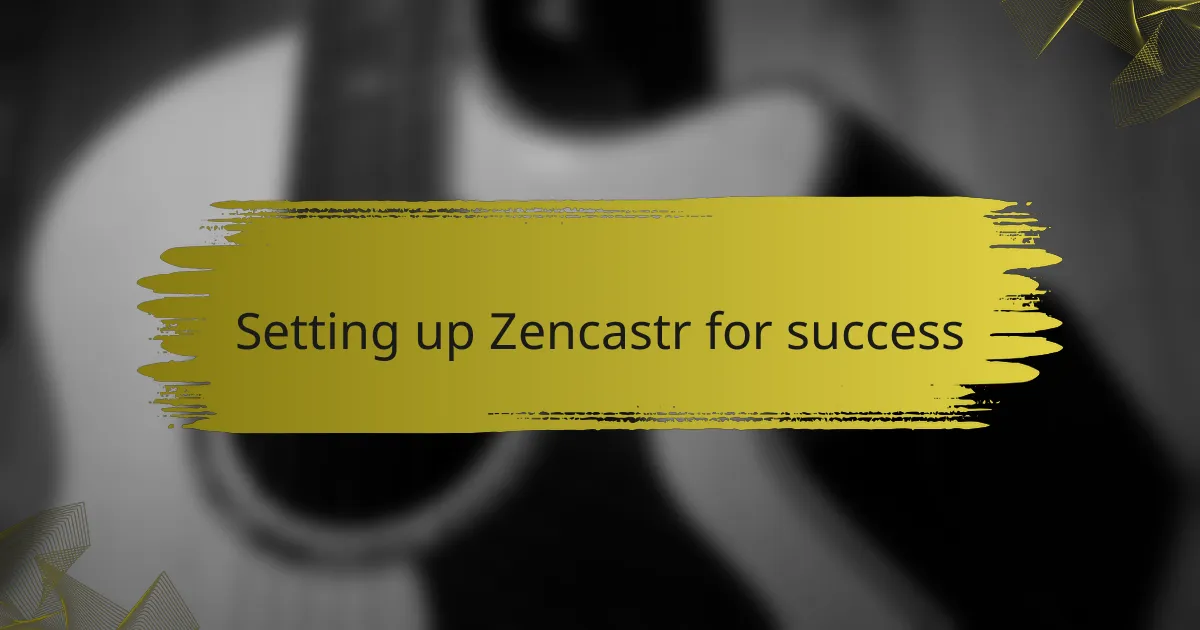
Setting up Zencastr for success
Setting up Zencastr for success is all about creating the right environment for your recordings. I recall the first time I got everything just right; it was a game-changer. I made sure to test my microphone and headphones beforehand, which meant that during the actual recording, I could focus fully on my guests, rather than dealing with any audio hiccups.
Equally important is the setup of your recording space. I’ve learned that a quiet, comfortable environment dramatically improves audio quality. Whether it’s a cozy corner of my living room or a designated studio space, minimizing background noise has made a noticeable difference in how engaged my listeners are. Have you ever listened to a podcast where the audio quality is poor? It’s distracting, isn’t it? That’s why I prioritize creating an inviting and controlled atmosphere.
Lastly, using Zencastr’s features effectively can elevate your recordings. I found that scheduling sessions and sharing links ahead of time really helps to keep everyone on the same page. Clear communication about the topics we’ll discuss not only prepares my guests but also builds excitement among my audience. This initial setup lays the groundwork for meaningful discussions that resonate with listeners long after the recording ends.
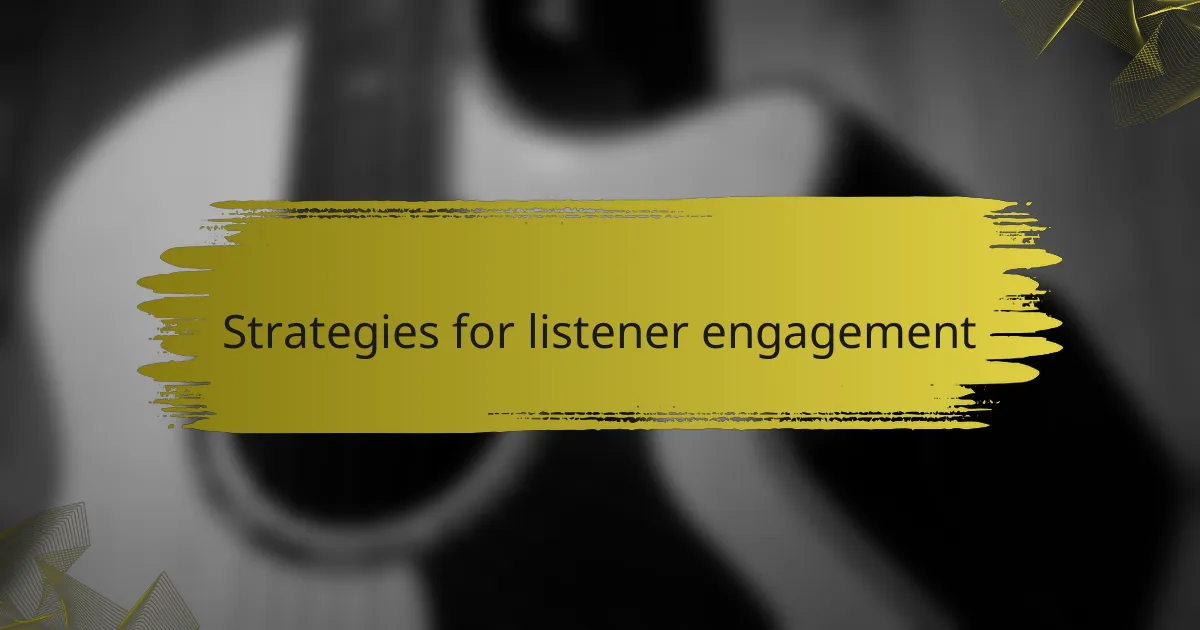
Strategies for listener engagement
When I first started using Zencastr for my independent radio show, I quickly realized how important it was to make listeners feel connected to the content. One effective strategy was to invite audience participation through live polls or questions. I’ll never forget the excitement of hearing a listener’s name during a broadcast because they contributed a thought that resonated so well with our topic. It created a real sense of community.
I also found that creating engaging stories can deeply resonate with listeners. By sharing personal anecdotes and relatable experiences, it encourages the audience to reflect on their own lives. Here are some strategies that have worked for me in enhancing listener engagement:
- Utilize interactive elements like polls and Q&A sessions.
- Share personal stories that relate to the topic at hand.
- Encourage listener feedback and read their comments on-air.
- Invite guests for interviews to provide different perspectives.
- Use social media to extend the conversation beyond the broadcast.
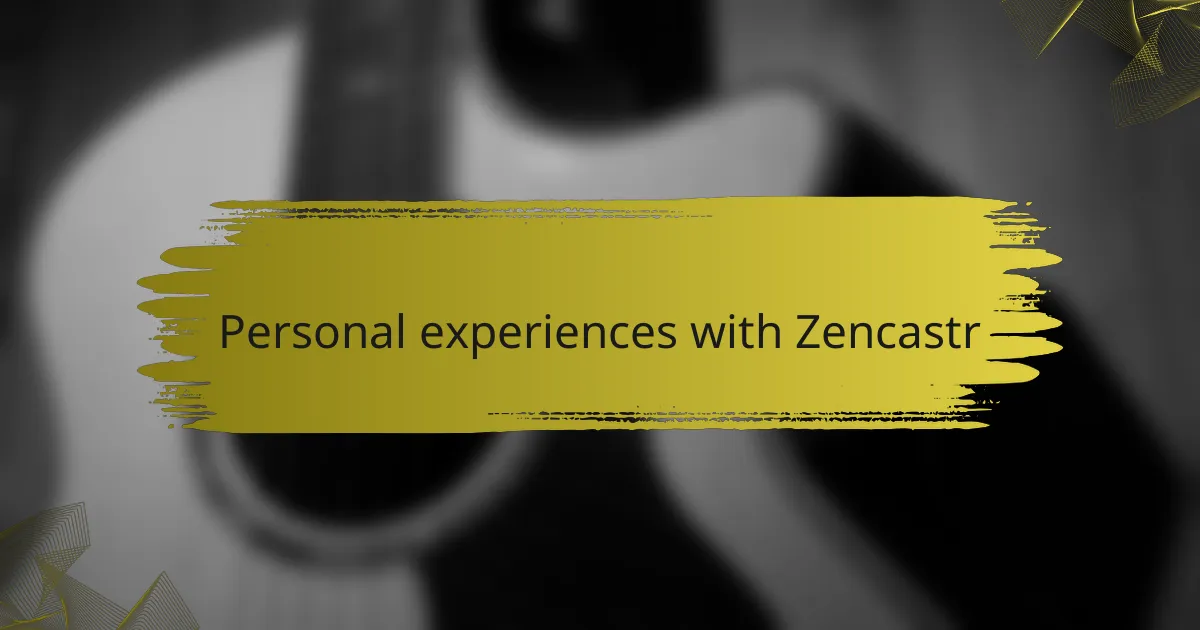
Personal experiences with Zencastr
Using Zencastr has transformed my approach to creating engaging audio content. I remember the first time I hosted a podcast episode with remote guests; I was a bit anxious about maintaining a smooth conversation. However, Zencastr’s high-quality audio recording and user-friendly interface put me at ease, allowing my guests and me to focus on delivering valuable content without worrying about technical difficulties.
One memorable experience was interviewing a guest from across the globe. The moment I hit record, I felt a connection despite the distance, and Zencastr captured every nuance of our discussion. It reinforced my belief that technology can facilitate genuine conversations, making even remote interactions feel personal and impactful.
Here’s a quick comparison table to summarize my experiences with Zencastr:
| Feature | My Experience |
|---|---|
| Audio Quality | Exceptional clarity, feels like in-person experience |
| User Interface | Intuitive and easy to navigate even for beginners |
| Recording Reliability | Never lost a recording, builds trust in the process |
| Guest Experience | Simplified for guests, makes it easy to join and engage |
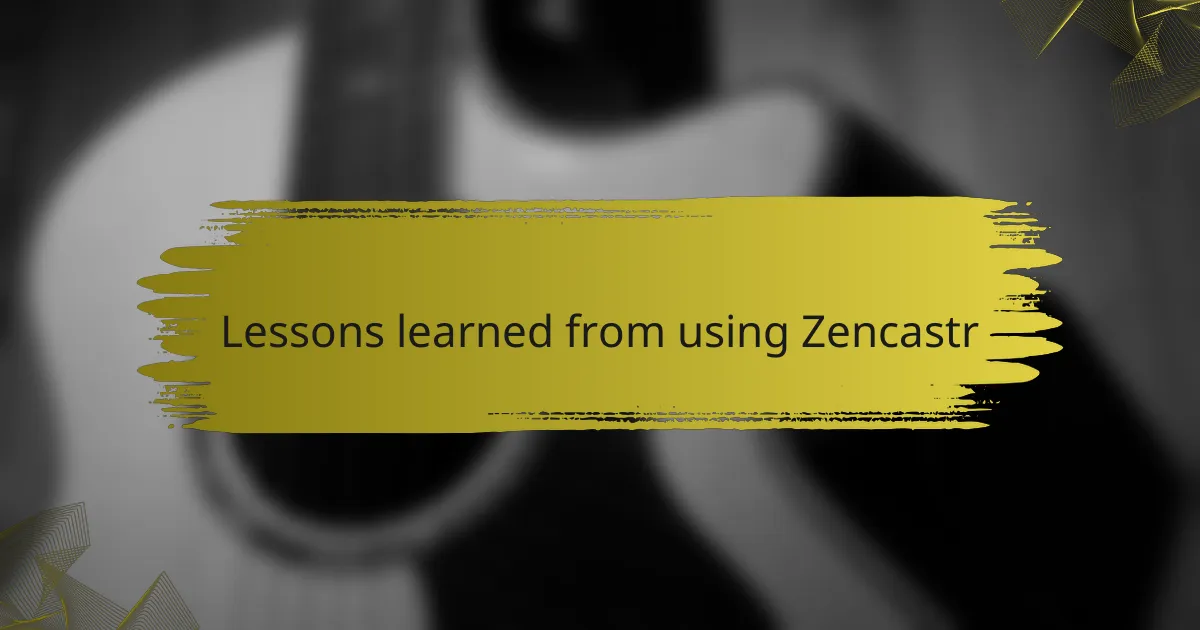
Lessons learned from using Zencastr
The journey of using Zencastr has taught me a few key lessons about enhancing listener engagement. One significant realization is the power of preparation. I remember a recording session where I had prepped my guests on the topics we’d cover. The smooth flow of conversation that resulted made me appreciate how vital it is to communicate expectations beforehand. When guests are prepared, they contribute more meaningfully, enhancing the overall experience for listeners.
Another crucial lesson revolves around the importance of audio quality. Early on, I had a session where the audio wasn’t perfect due to background noise. It really hit me how distracting that can be for listeners. I learned to prioritize creating a controlled recording environment. Now, I always ensure that I’m in a quiet space, and I encourage my guests to do the same. It has made a noticeable difference in the engagement levels of my audience. Who would have thought that something as simple as reducing noise could lead to such a significant impact?
Lastly, I found that following up with listeners after a show can significantly enhance their connection to the content. After one episode where we tackled a sensitive topic, I received numerous messages from listeners sharing their thoughts and experiences. It was heartwarming and reminded me that engagement doesn’t stop at the end of a recording. Instead, I’ve learned to foster ongoing conversations by responding to feedback and including audience contributions in future episodes. It’s these connections that turn casual listeners into loyal fans.
